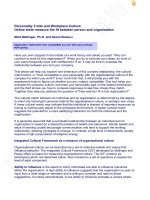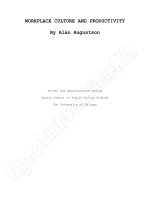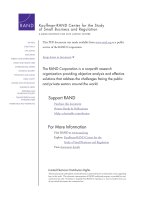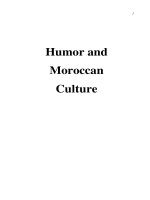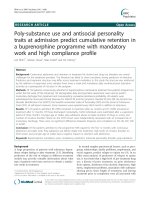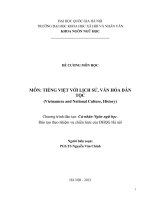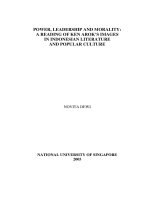Personality Traits and Workplace Culture
Bạn đang xem bản rút gọn của tài liệu. Xem và tải ngay bản đầy đủ của tài liệu tại đây (304.36 KB, 7 trang )
Personality Traits and Workplace Culture:
Online tests measure the fit between person and organization
Mark Mallinger, Ph.D. and Ileana Rizescu
Application: Determine how compatible you are with your primary
work group.
Have you ever stopped in the middle of a work frenzy and asked yourself, "Why do I
continue to work for this organization?" When you try to promote your ideas, do most of
your peers frequently react with indifference? If so, it may be time to evaluate the
relationship between you and your company.
This article will help you explore one dimension of this complex relationship: the cultural
match factor, or "How compatible is your personality with the organizational culture of the
company for which you work?" Even more than that, it will provide you with the
assessment tools to figure out whether you are, indeed, compatible. One tool helps you
evaluate the company culture, one tests your personality type on the related dimensions,
and the third shows you how to compare responses to see how closely they match.
Together they help you address the question of "How well do I fit in this organization?"
The cultural match between an individual and an organization is determined by the degree
to which the individual's personal traits fit the organizational culture, or perhaps vice versa.
A lower cultural match may indicate that the individual is drained of important resources by
having to continuously adjust to the workplace environment. A higher cultural match
suggests the potential for a more satisfying interaction for both the individual and the
organization.
It is generally assumed that a successful relationship between an individual and an
organization is based on a shared foundation of beliefs and behaviors. Similar beliefs and
ways of working usually encourage communication and tend to support the working
relationship, allowing synergies to emerge. In contrast, a high level of dissimilarity usually
requires a high consumption of adaptive energy.
Integrated Cultural Framework as a measure of organizational culture
Organizational culture can be described as a set of collective beliefs and values that
influence behavior. The Integrated Cultural Framework (ICF) developed by Mallinger and
Rossy offers a means for measuring organizational culture. The ICF contains six
dimensions which are described below. Also included is a set of questions to assess the
level of each component.
Ability to influence is the extent to which individuals are able to influence outcomes
within the organization. A high ability to influence suggests that the organization is open to
input from a wide range of members and is willing to consider and react to those
suggestions. It is likely decentralized. A low ability to influence indicates a culture where
most individuals have little chance to impact the outcomes. Decisions are made by a small
group of individuals at the top who are not open to input from more than a select group of
employees. Assessing questions include:
• Where are decisions made within the organization?
• Is the organization centralized or decentralized?
• To what extent can most members participate in changing procedures and policies?
Comfort with ambiguity describes the extent to which the members of the organization
are comfortable with uncertainty and risk taking.
• Are there lots of rules and regulations that explicitly define the way "things should
be done here?"
• Can decisions be made without complete information?
• Is risk encouraged?
Achievement Orientation refers to the extent to which the members of the organization
are striving to accomplish goals and improve performance.
• Is goal accomplishment the norm?
• Is there a high expectation of achievement?
Individualism vs. Collectivism refers to the extent to which the members of the
organization are encouraged or given incentives to focus primarily on personal gain
(individualism) versus considering first the interests of the group as a whole (collectivism)
• Are rewards individual or group based?
• To what extent do members work as a team?
Time Orientation measures the extent to which the organization's missions/goals are
focused on values from past, present or future. However, combinations of time orientation
can exist. For example, an organization may demonstrate both present and future
orientation (e.g., focus on bottom line, while also engaging in meaningful strategic
planning)
• Is the vision based on the values of the founders (i.e. past), the current environment
(present) or an estimation of the future?
• Is the implementation of the strategy past, present or future oriented?
Space Orientation refers to the extent to which physical layout is public, private or a mix
of both.
• To what extent is office space shared?
• To what extent do you see closed versus open doors?
• To what extent are members protective of their space?
IPIP-NEO Personality Test
As a personality assessment tool we have chosen the International Personality Item Pool
(IPIP-NEO) Test because it has a fairly large number of personality traits that can be
associated with the cultural dimensions used to describe the organization. The IPIP-NEO
Test estimates the individual's personality on five broad domains (known as the Five-
Factor Model) and 30 sub-domains. The test measures normal differences in personality
and it is based on, but it is not equivalent to, the NEO PI-R™, authored by Paul T. Costa,
Jr. and Robert R. McCrae. A reduced version of the test can be taken for free. The
comprehensive version of the test is also available.
For the purposes of comparison, a smaller group of characteristics has been selected from
the larger pool of six traits within each of the five domains. Some traits, such as
immoderation or artistic interests, were deemed not relevant for defining a match with the
cultural dimensions listed above Consequently, we only will describe, briefly, those traits
that are used in linking personality and organization culture.
Extraversion
• Friendliness: The ability to quickly establish relationships with other people.
• Gregariousness: The level of social engagement. High scorers enjoy the company
of others and tend to be comfortable in groups. Low scorers have a greater need for
privacy and tend to avoid large groups of people.
• Activity Level: Active individuals get involved in many activities, leading fast-paced
lives. People with a low activity level enjoy a more leisurely, slower-paced life.
Agreeableness
• Trust - the capacity to rely on someone else's integrity, ability or character.
• Altruism - the need to help others, viewed as a form of self-fulfillment.
• Cooperation - the ability to lower the priority of personal needs in order to get along
with others.
Conscientiousness
• Self-Efficacy - the confidence in one's ability to accomplish goals.
• Achievement - Striving. High scorers have a strong achievement drive and wish to
be perceived as successful. Low scorers don't value social recognition as much and
are satisfied performing at a level with which they are comfortable.
• Cautiousness - the disposition to analyze all possibilities before taking decision or
acting. Low scorers often do or say what comes first to their mind.
Neuroticism
• Self-Consciousness - the degree to which an individual is sensitive to what others
think about him or her. High scorers indicate a concern about being criticized or
rejected by others whereas low scorers are less concerned about judgment from
others.
Openness to Experience
• Adventurousness - the degree to which one looks for new experiences. High
scorers are not comfortable with routine, while low scorers tend to feel
uncomfortable with change, preferring familiar routines.
• Liberalism - the psychological meaning of the term refers to the readiness to
challenge authority, convention and traditional values. Low scorers are called
conservative and prefer security and stability brought by tradition.
Comparison between organizational cultural features and matching personality
traits
In selecting the personality traits that match the organizational cultural framework, the
personality trait within a cultural dimension should enable the individual:
• to feel comfortable in the specific organizational environment.
• to feel motivated by this environment.
• to be able to deliver the expected results for the organization.
The following table offers the means to assess the degree of cultural match between an
individual personality and an organizational culture. To illustrate this, you are invited to
take the personality test referenced above and compare the results with the cultural
climate of your own organization or another with which you are familiar.
When carrying out the cultural assessment, select a unit of analysis that is related to your
organizational identity - the segment of the business with which you most identify as your
work group. Depending on size, location, or divisional responsibilities, the unit of analysis
might be the corporation, the division, the department, or the functional arena.
The first column of the table contains a listing of the organizational culture traits measured
at the ends of the scale, each of them being assigned a value (1 or 3) in parentheses.
Because the "low" and "high" values used by the Integrated framework scale could not be
compared directly with the "low" and "high" values offered by the IPIP measure, we have
introduced numerical values from 1 to 3 to make the comparison possible.
The second column is to be filled in with the scores that reflect your company's culture. For
example, if, in your opinion, your company ranks high on "ability to influence," you will
assign a 3. If there is moderate "ability to influence," you will score it a 2.
The third column offers a short description of the matching personality traits for each
organizational culture feature. The fourth column specifies the corresponding IPIP-NEO
measures, and the numerical score associated with each. Use the fifth column to calculate
the average score of your personality traits for that line. For example, if you scored high on
liberalism (3) and medium on self-efficacy (2), your IPIP average score will be 2.5.
After grading both organizational culture and your personality, the comparison between the
second and the fifth column will show the degree to which the scores match. A strong
match is suggested if the columns contain equal scores or are within a 0.5 difference. A 1-
point difference between the corresponding scores may reflect an incongruity, whereas a
2-point difference is likely to indicate a misfit.
Organizational Culture-Personality Comparison Chart
Organizational Culture
Feature
Your
Org.
Score
Description of
Matching Personality
Traits
IPIP-Neo Measure
Your IPIP
Ave.
Score
High ability to influence
(3)
Low ability to influence
(1)
Challenges authority,
likes to be empowered
Respect for hierarchical
structure, needs
direction in life
High liberalism (3) High
self-efficacy (3)
Low liberalism (1) Low
self-efficacy (1)
High comfort with
ambiguity (3)
Low comfort with
ambiguity (1)
Adventurous, risk-
taking
Rigorous, cautious
Low caution (3) High
adventure (3)
High caution (1) Low
adventure (1)
High achievement (3)
Low achievement (1)
Achievement striving,
active
Follower,
contemplative, less
concerned with high
achieve.
High assertive (3) High
activity (3) High achive.
(3)
Low activity (1) Low
achivement-striving (1)
Collectivism (3)
Individualism (1)
Cooperative, "Doing for
others," Trust
Independent, Don't like
to share, Little trust
High cooperation (3) /
High trust (3) High
altruism (3)
Low cooperation (1) /
Low trust (1) Low
altruism (1)
Present-future
orientation (3)
Past-present orientation
(1)
Liberal, open to future
experience
Conservative, stability,
tradition
High liberalism (3)
Low liberalism (1)
Public (3)
Private (1)
Friendly, seeks
company
Reserved, needs
privacy
Low self-consciousness
(3) High gregariousness
(3)
High self-
consciousness (1) Low
gregariousness (1)
To enhance the model presented in this article, it is important to be aware of the following
considerations:
